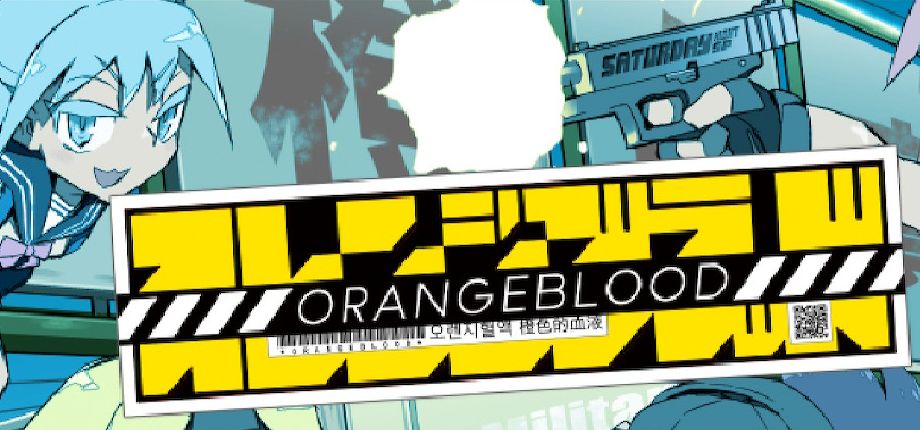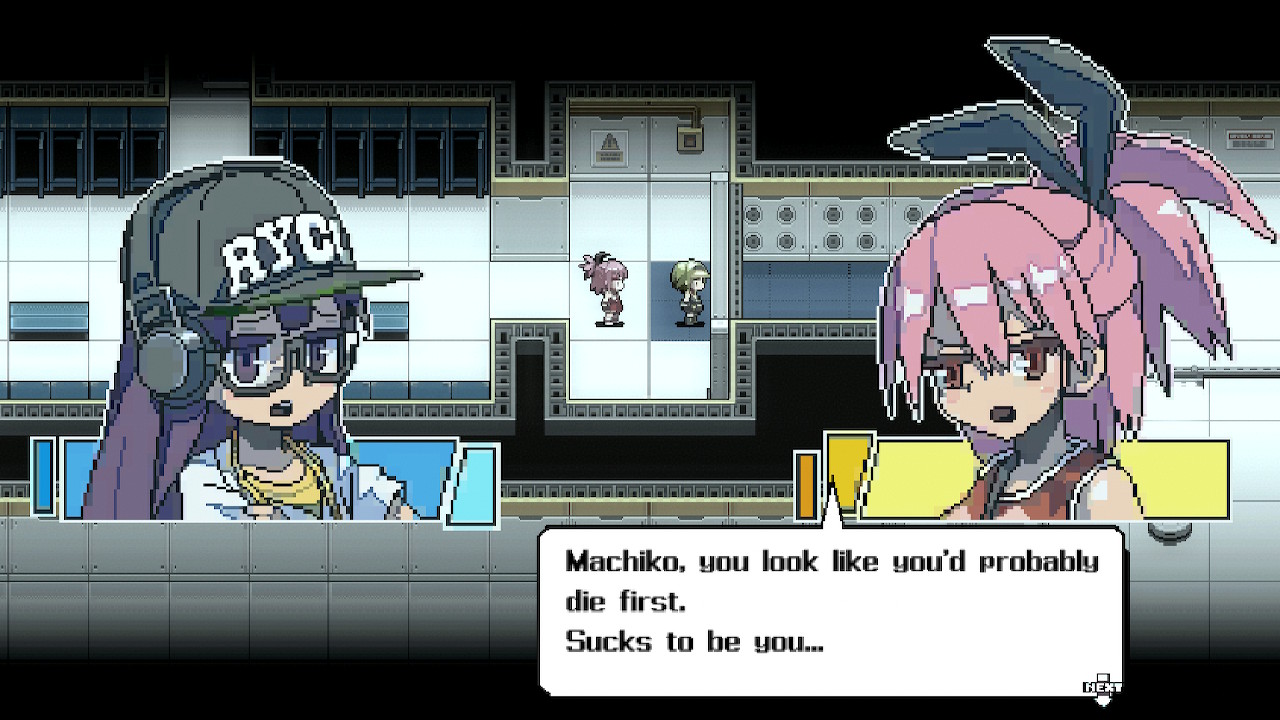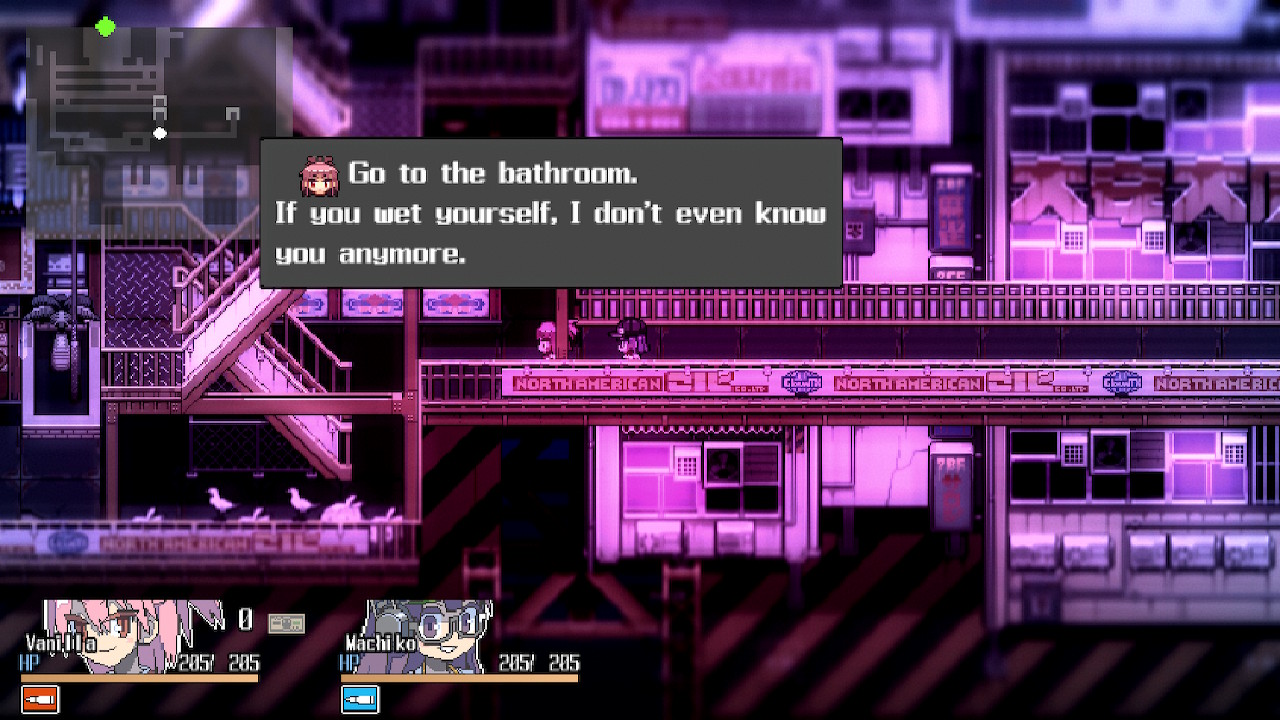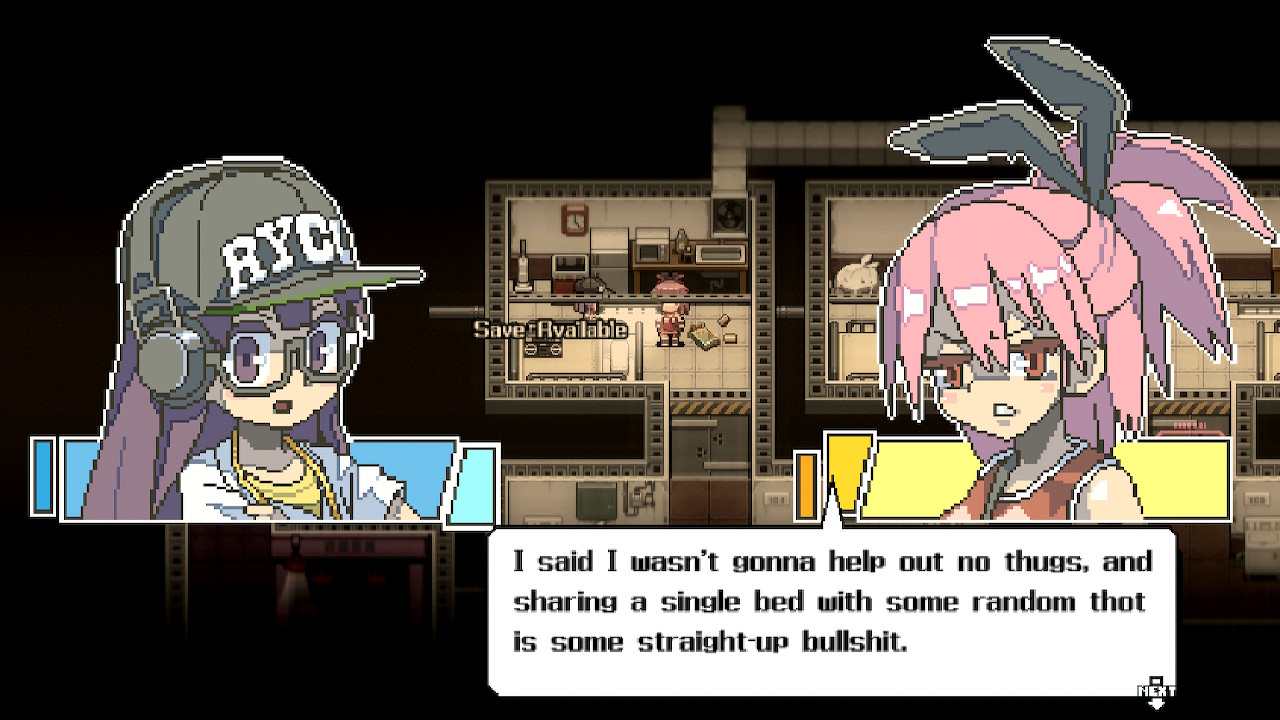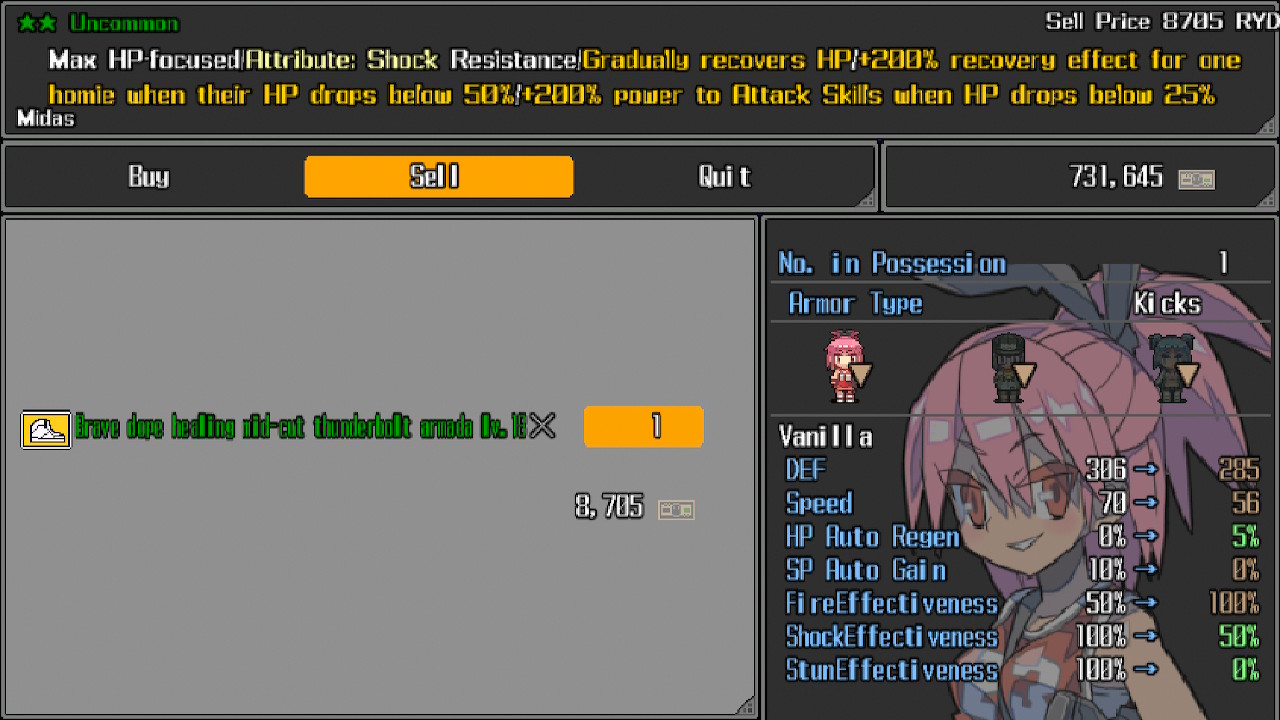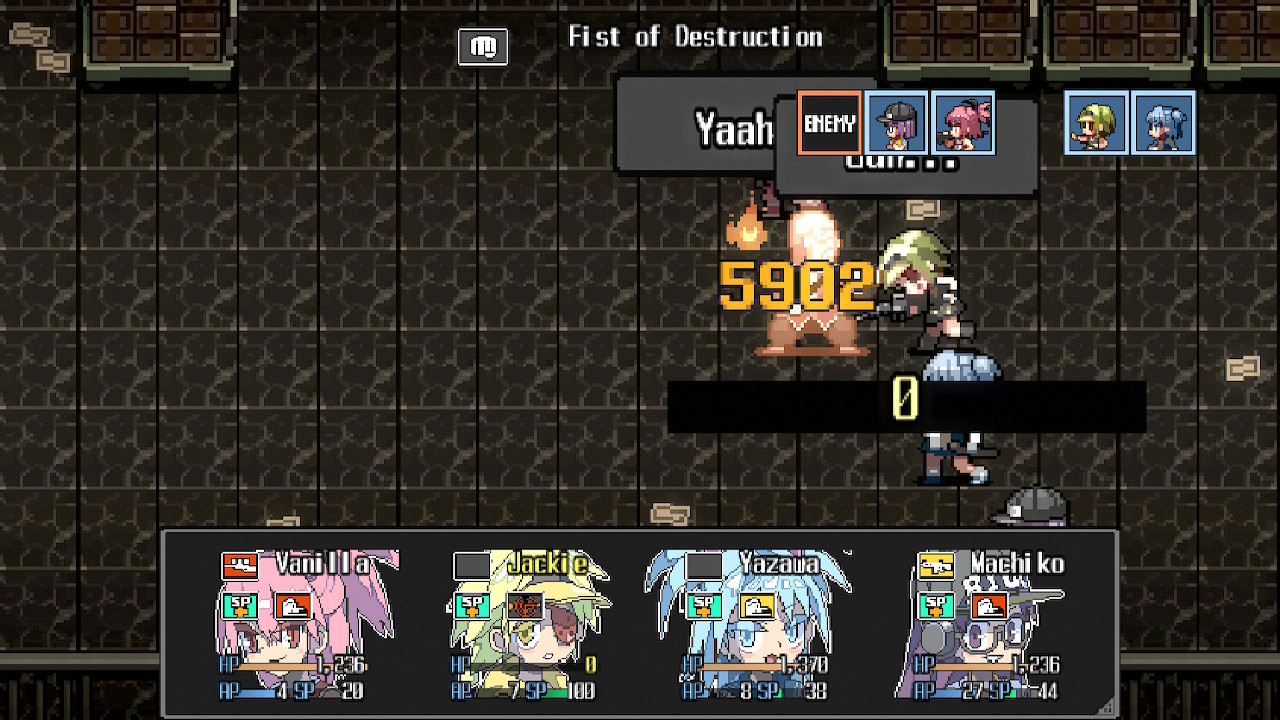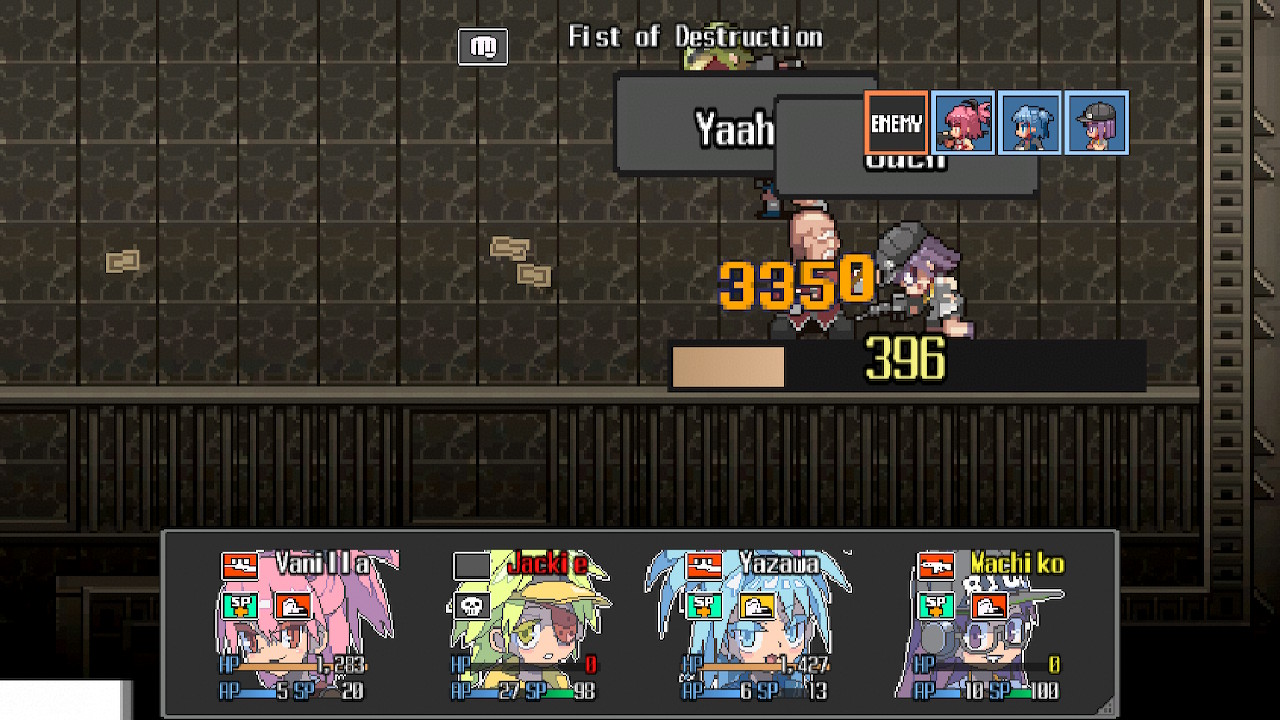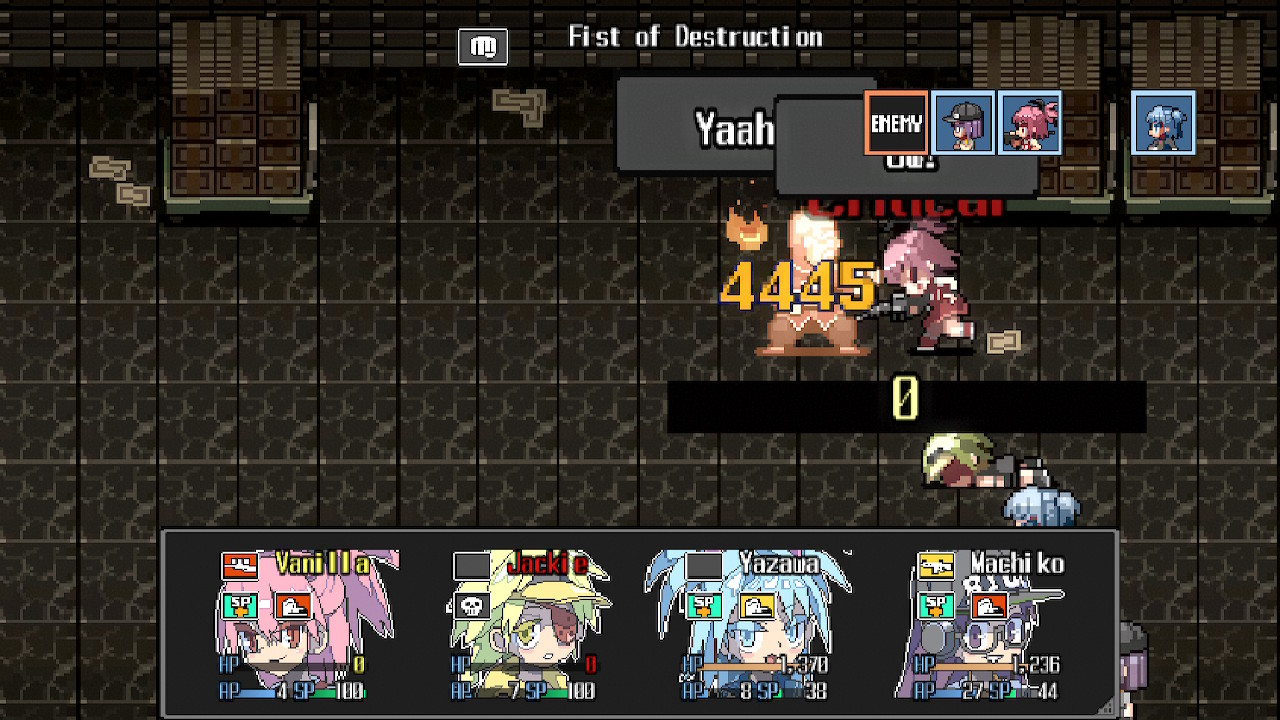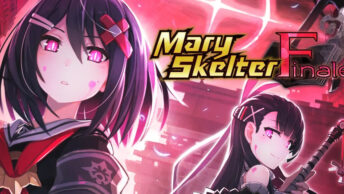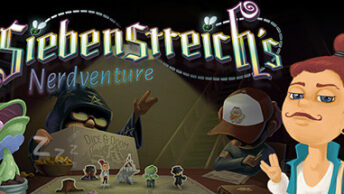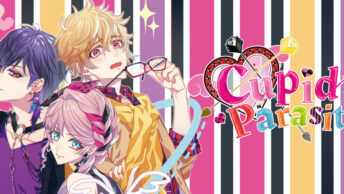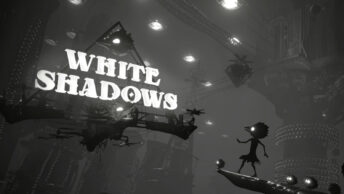OG Japanese schoolgirl gangsta rappas in da hood! [CRINGE]
Type: Single-player
Genre: RPG, JRPG
Developer: Grayfax Software
Publisher: Playism
Release date: 1 Oct, 2020


Intro
Orangeblood is a game with a really strong and odd high concept to throw at you. That’s good because it doesn’t have much else to throw at you besides its raw aesthetics. That said, I was happy to play it thanks to raw aesthetics, alone. Sometimes, something fresh and new is all you really need… so long as it doesn’t overstay its welcome, but this isn’t a terribly long game, either.
The game is set in an “alternate timeline” around 1998. The “alternate timeline” thing is an excuse to throw hovercars and (apparently) sentient robots into a setting that also still uses cassette tapes, CRT televisions, and cell phones the size of a cinder block. The game also takes place on an oil rig south of Japan being fought over by the Yakuza, Triads, Mafiya, and some black street gangs for good measure, and was originally built as a CIA black site. Oh, right, and apparently the Nazis still exist in Germany in this timeline, too, because someone wants to sell government secrets to them at one point.
So, after taking a concept that can ring a lot of my bells like “Hip-hop cyberpunk gang wars over CIA secret projects”, how well does it translate as a game?…
The Cringe
So one thing I have to get out of the way first, which will probably dictate whether you love or hate the game is the dialogue. Remember that whole “alternate timeline 90’s” thing? Well, it’s alternate timeline 90’s gangsta rap. Basically everyone in this game talks like they’re cribbing notes from Straight Outta Compton. Whether you personally find this awesome or awful is basically going to determine if it’s possible for you to enjoy this game at all.
I’ll admit it: I’m whiter than rice on a paper plate in a snowstorm. So I went online to see how others reacted to the language this game uses. The majority of responses seemed to be that the dialogue was cringe, and it pulled them out of the game. One response was that the poster grew up in a urban poor black neighborhood in Canada, and it’s highly accurate to the way they speak, to the point he thinks the translator must have come from similar circumstances.
However, there’s a notable difference between, say, a 50 Cent game written where 50 Cent talks like 50 Cent and a game written by some Japanese guy about Japanese schoolgirls that talk how the Japanese think rappers talk and then translated to sound like 50 Cent.
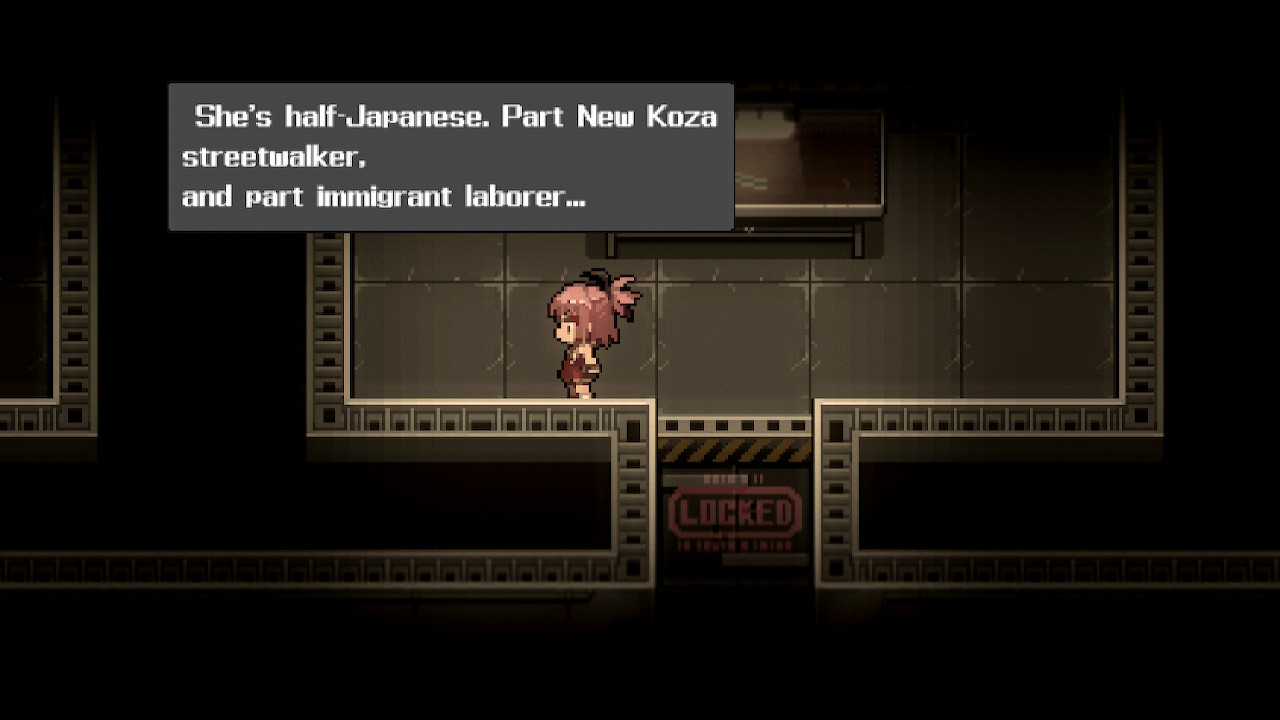
To be fair, the translator did a good job if there even is a question whether it’s cringe or not. Attempts at rap in some of the anime I’ve seen tend to be 100% pure refined cringe, and frequently consist of just saying “yo” 20 times in a row…
For “Mature” Audiences Only
While the port to the Switch was most certainly not a good one, there’s something particularly juicy about playing a game like this on a Nintendo console in particular. I grew up with the Super Nintendo being notorious for having the “sweat drops” instead of “blood” Mortal Kombat. Nintendo has a kid-friendly image it tries hard to protect. While Orangeblood is far from the first Nintendo console game to really try to be transgressive, I still can’t help but love the fact that I’m playing a game where the teenaged Japanese schoolgirls (that is, if Vanilla had ever gone to school, she would be) take over a “bakery” (drug factory) by executing its former owners before doing a line of coke before tripping balls and winding up shooting little green men they hallucinate.
(Of course I’m not making that up.)
Practically every named character in the game is a flamboyant psychopath. You probably wouldn’t want to know any of these characters in real life (besides maybe Machiko), but their sheer absurd potential for violence helps lift a crapsack world that would otherwise be uninteresting because you have no interest in what happens to any of the characters into black comedy where I can’t help but root for the lovable psychos.
Main character Vanilla Vincent, in particular, is an absolute bastard (in every sense of the term). There’s basically not a single person she gets into business with she doesn’t double-cross besides the all-girl party members and the (also a cute girl) hacker she needs to get through security. Even among these people, she treats Machiko like a lackey, doesn’t bat an eye when the hacker gets tortured, and works with her torturer.
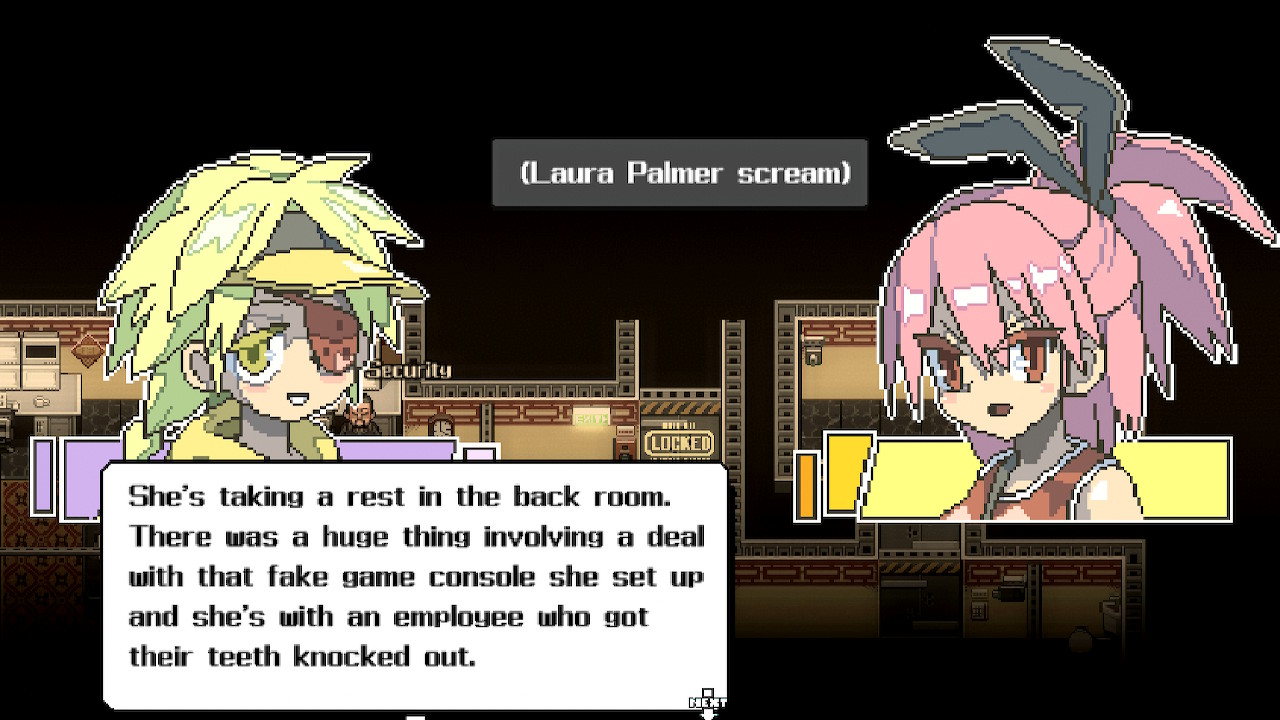
She also has a running gag about constantly telling Yazawa she can’t kill people everywhere she’s going. (This includes a line about how “people aren’t carrots, you can’t go slicing them up everywhere you go!”)
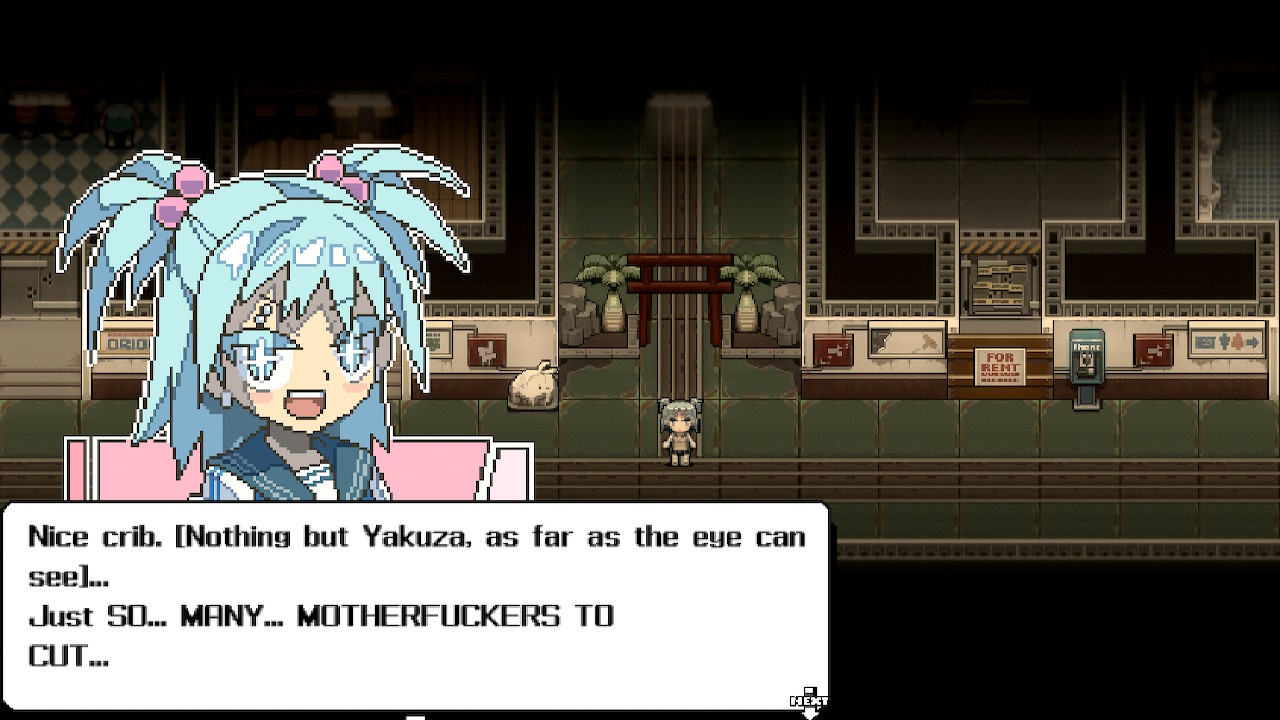
For a game that’s supposed to be set in the late 90s, it actually gets something about the way that 90s games were trying to break out of the restrictive “won’t someone think of the children” mold down pretty well. Somewhat like Grand Theft Auto, Orangeblood revels in having a lot of “mature” themes, but doing so in a deliberately immature way.
I’ll Make My Own RPGMaker, with Blackjack and Hookers!
RPGMaker is well-known for having low-effort RPGs, where somehow the ones given away for free show more effort and creativity than the ones that litter the Steam store page. It’s not entirely the fault of the engine, but being a beginner-friendly engine (much like Unity) means that a lot of hacks that just reuse the basic assets to put out a generic and unmemorable game pop up using the engine.
In fact, when I try to list examples of good games made on RPGMaker, they are pretty much exclusively games that aren’t RPGs. Games like Yume Nikki, To the Moon, or Always Sometimes Monsters are more like point-and-click adventure games or walking simulators than RPGs.
Also, I’m not just referencing Futurama, here. This game really does have blackjack and hookers (albeit less interactively than one might enjoy).
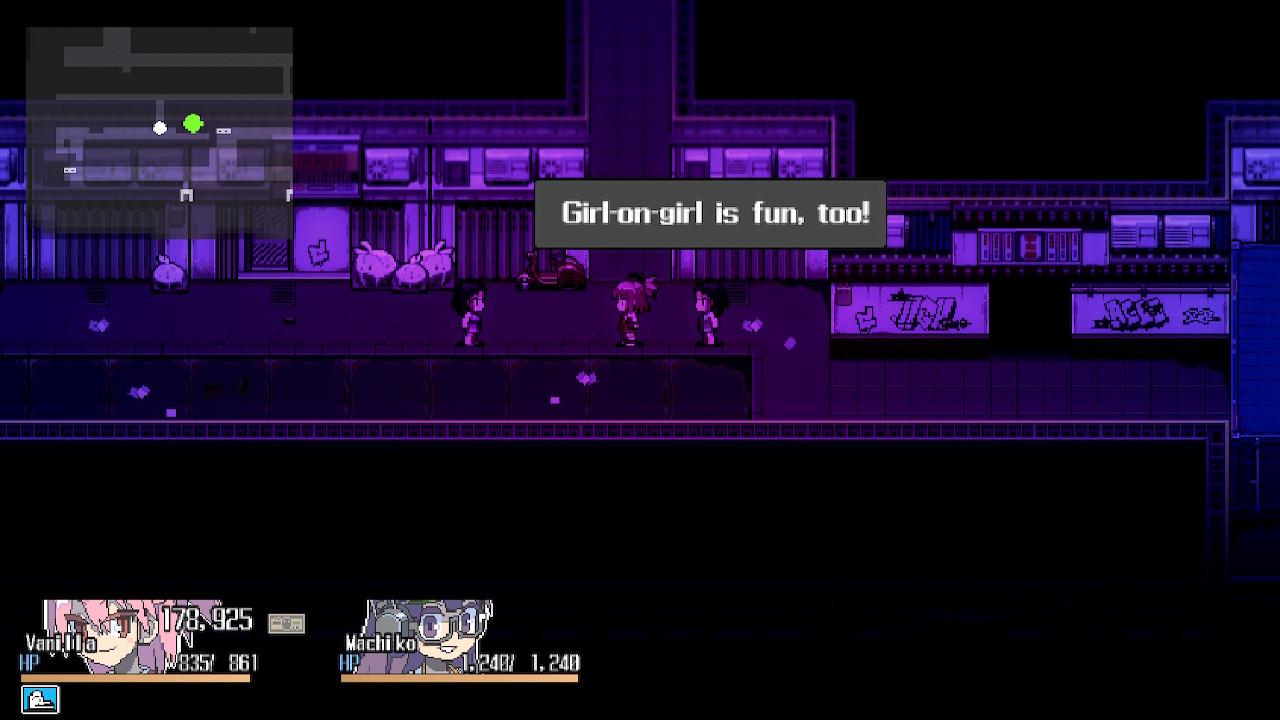
In fact, the game is full of oddball stuff you can enjoy. You can sit on most benches, even ones inside the dungeon areas, and Vanilla will light up a cig and take a smoke break next to the following character who does her own thing. Go to the roof of the club, and you can hit golfballs out at traffic (which cause random car alarms to go off or explosions off-screen). Once you unlock the nicer cribs, you can even take a break in a hot tub or sunbathe.
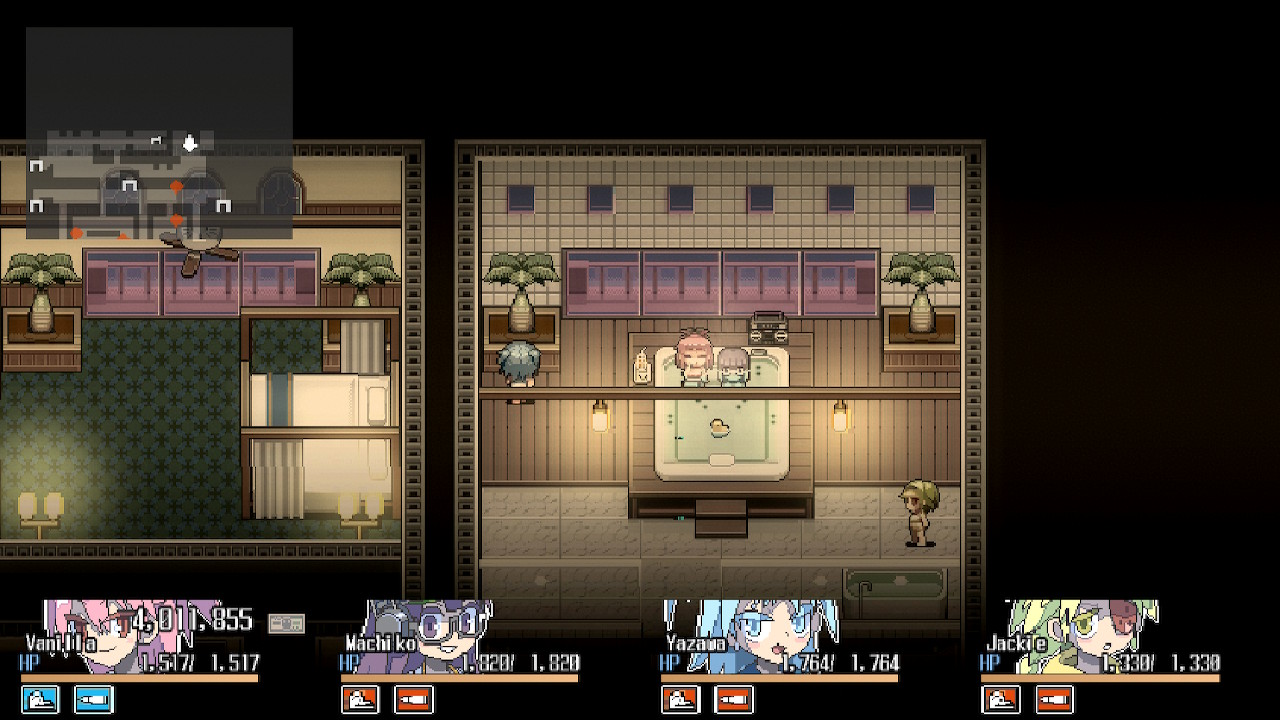
There’s gameplay effects to this, as well. Root beer vending machines (only root beer – I guess it’s the dev’s favorite) and hot dog vendors are essentially healing stations. Root beer vending machines are found even in dungeons (and curiously never run out of stock), for mid-dungeon healing.
Rocket Tag Combat
This would sound strange in any context other than JRPGs, but shotguns to the face are surprisingly lethal in this game.
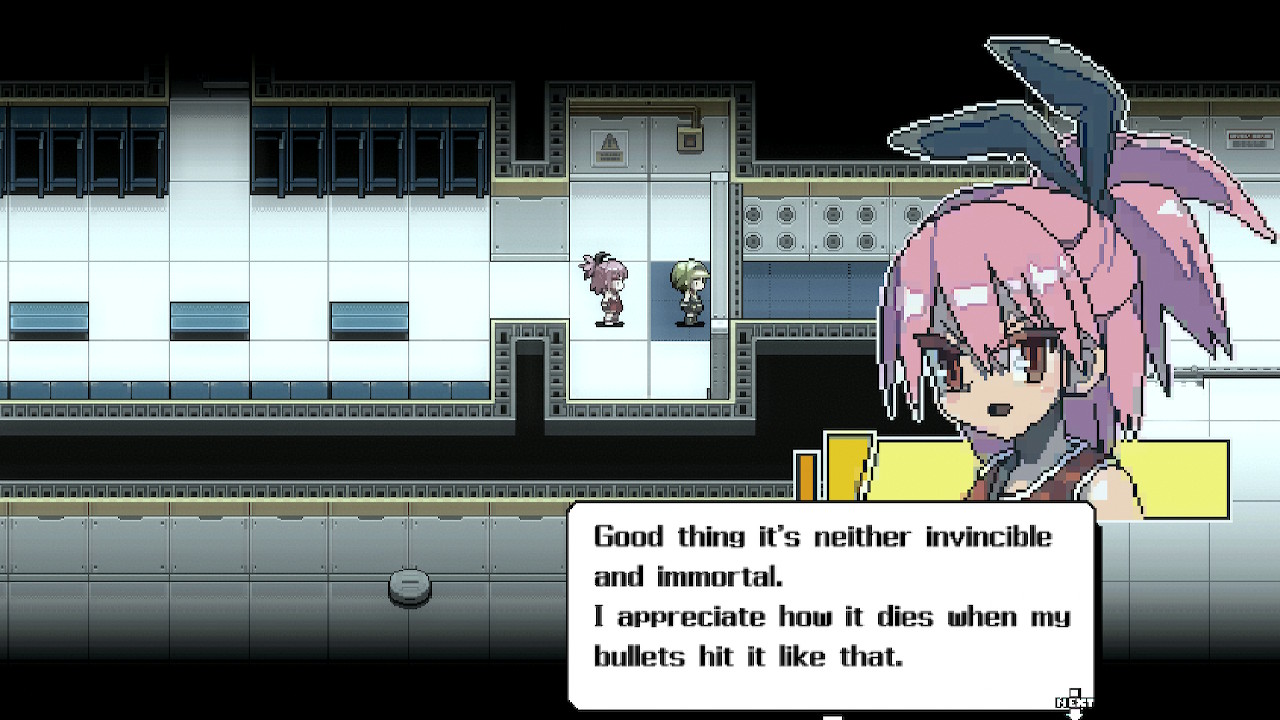
Maps are divided between ones with and without combat. Combat maps let you fire a pistol by pressing the confirm button (A button) (you activate things just by walking into them), and shooting an enemy token on the map very briefly stuns them so that running into them gives you extra SP at the start of battle. (Note that shooting them twice doesn’t reset the stun duration, so you can’t keep them stunned.)
Your choices in combat are extremely limited.
You can fire your gun, which has “AP”, or “ammo points” – lord knows why it needed to be “points” – as your standard attack.
There are four types of weapons, and all characters can equip any type. Anti-material rifles attack a single enemy once, and are fairly powerful. Assault rifles attack a single enemy with a burst of fire (depending upon the rifle, between 3 and 7 shots per burst), with each bullet rolling for criticals and status effects it can apply seperately. Shotguns attack all enemies once and are powerful, but have low accuracy. Submachine guns (SMGs) attack random enemies up to 10 times, and effectively can attack all against many enemies, or concentrate fire when only one is left, but each shot does significantly less damage than other weapons. This adds some tactics and variety, but it does so only outside battle, and you’re married to your gun once the shooting starts.
Every character has at least one unique skill that takes up a large chunk of SP. There are also “instant skills” that grant a buff immediately and let you take other actions (including more instant skills), and most come from purchasable or findable items. Instant skills notably take up SP and have a significant cooldown period, meaning you probably get to use each one once per battle, as even boss fights rarely lasted the five rounds it took to cool down any skills.
At the start of the game, you get Machiko, who starts every round off either giving every party member 10 SP or 10% HP restoration, provided she’s not dead. Both are precious, as there is no item use (besides equipment) in combat, and unless your equipment gives regeneration, there is basically no way to recover HP in combat without Machiko. There is a skill to revive another character, but it takes 50 SP, has a 10-round cooldown, takes half the using character’s health, and restores only 10% of the target’s health. All restoration abilities are based upon percentages of max HP, although Machiko’s unique skill can fully restore the whole party. If any battle goes long, getting Machiko up to 80 SP to use her special is absolutely vital.
That said, all the other characters have fight-winning specials. If you get the bonus 50 SP for shooting an enemy on the map before battle starts, you basically win automatically. Every normal enemy fight winds up looking like this if you have any idea what you’re doing:
You have levels, but only HP, Def, and Speed go up with levels, and even those are much more heavily impacted by equipment than levels. All characters have the same base stats for any given level. You have three equipment slots. Your weapon is obvious, your “kicks” are basically your armor in a standard JRPG, and your “gear” is basically an accessory slot (even though most of them are types of body armor). Gear tends to give a massive boost to one particular stat. So for example, ballistic helmets boost speed. You start the game with about 40 speed and go up to about 60 by around level 30, when you’re beating the game. Even first-level ballistic helmets give you about +100 speed, and level 30 ones give up to +250. Turn order is not random, so even one extra point of speed means you always go first. Like I said, equipment trumps character stats by a huge margin.
So in the video above, I just make Yazawa wear equipment that gives +200% special attack power and have blazing high speed so she always goes first, then use an ability that attacks all enemies to one-hit-kill the whole enemy side in the first move. Every non-boss battle is like this. There aren’t many enemy types and they get recycled a lot, but there are still several I have never even seen get a turn. This strategy basically works all by itself until a boss fight or the last stages where enemies get enough HP to actually require more than one character attack to kill them off. Even before getting Yazawa, just having Machiko fire a shotgun and then letting Vanilla use her special to finish off anyone that dodged kills the whole enemy party.
Oh yes, equipment has levels, too. The game has an odd half-rubber-banded approach. Every combat area will have its own level, but about half your own party’s level is added to it, so enemies get stronger as you do, but not as fast as you grow in strength, so early areas are still notably weaker than late areas and getting to late areas without fighting much will leave you underleveled. Still, if equipment is all that matters, who cares, right? Well, equipment is leveled, too, and equipment levels are equal to the level of the enemy in the area. In other RPGs, I would love this half-rubber-banded approach, as a full rubber band (like, say, TESIV: Oblivion) makes leveling feel worthless, and a half-rubber-banding approach can give some of the benefits of not making areas you outlevel wastes of time. That said, in an “only equipment matters” game, levels just mean that your equipment is growing obsolete compared to an enemy whose stats grow across the board with every level.
Equipment uses the Diablo model. There are some base equipment types that get bonus attributes and effects randomly, with the name of equipment extending as more effects are added. Color-coded rarity levels designate how many bonus attributes are likely to be on a given item.
Equipment also comes from loot boxes that require keys that drop from enemies. It’s possible to skip past enemies and loot a bunch of crates for gear all at once, but keys hold you back if you skip too many. That said, if things are easy now, stockpile keys and cash them in when you’re having trouble, since new equipment will be higher level and therefore have higher base stats.
Equipment also has game-breakingly powerful synergies. At one point, I had Vanilla using an SMG with the “gas leak” trait that made her catch fire (a status effect) while gaining +50% attack power, and also using equipment that made it so that if she caught fire, she also gained +100% hit rate and +50% crit rate. Vanilla’s special allows her to attack eight times in a row on randomly selected enemies, so she typically kills one enemy and then the fire effect kicks in, letting her deal even more damage with successive attacks.
However, just because you can easily set up equipment combos that curb-stomp the normal enemies doesn’t mean it’s all easy. The bosses are ludicrously unbalanced – not just compared to normal enemies, but even compared to one another. Half of all bosses are easily-stomped jokes, and the other half stop your progress like you’re slamming face-first into a brick wall.
To make up for the action economy, all bosses get four attacks (unless the bosses attack in pairs, in which case each gets two attacks), and this often means a boss’s turn is 30 uninterrupted seconds of slamming your party. Boss attacks start off being able to cut half your HP out per round, and go up to one-hit kills four times per round. The only silver lining is that they’re still vulnerable to your absurd equipment combos with +400% total bonus to attack, and Vanilla can kill bosses in the first 2/3rds of the game in a single special – she just needs to survive until she gets 50 SP, first.
One extra thing of note is that defense is weird in this game. At first I thought it was the standard “subtracts damage” model, and was therefore useless, because you could have between 100 and 400 Def and be taking attacks for 5,000 damage. However, very late in the game, I found that equipment that drops defense to 1% of its normal levels actually makes a character take about 10 times normal damage… so it’s apparently an attack divided by the square root of defense model? Regardless, defense stacking just doesn’t make sense in a game where taking hits at all is lethal.
As I said, combat is ludicrously lethal. I effortlessly kill most enemies in one round, but if they ever get a chance to move, I often find that they can kill my characters in one hit, themselves.
Then, I hit THE boss. One event has you cleaning out a vault full of money, and after you are in the fight with him the game warns you that this boss gets a power-up (of up to +300% HP and attack power!!) based upon how much money you took. There was no warning beforehand. This battle looks like this:
When I tried to restart and do this without stealing any money, I found that this guy started out stronger than any previous boss in the game, capable of one-shotting any character, and having twice as many hit points, but stealing all the money will quadruple it, anyway!
Money has no real value at this point in the game, so I could beat him without taking money if I got lucky and he didn’t use his “+100% accuracy and +50% critical hit” skill that makes him insta-gib every party member and I get lucky dodging, but being practical is for losers! I wanted to win “properly” by taking as much money as I could, even if it meant retrying and retrying again while only taking 1/3rd of the money…
I tried a half-dozen times…
I had about 48 keys by this point, so I went back to the previous stage, and tried grinding up some more gear, blowing nearly all of my keys for something that might help raise my evasion or something…
I finally went back on a loot run, and accidentally ran into this game’s equivalent of a metal slime, a walking loot box enemy. Killing it, I got a unique weapon with a special property that was particularly interesting…

See the enemy boss? The game lets you check its stats, and they notably list the boss as having no status immunities.
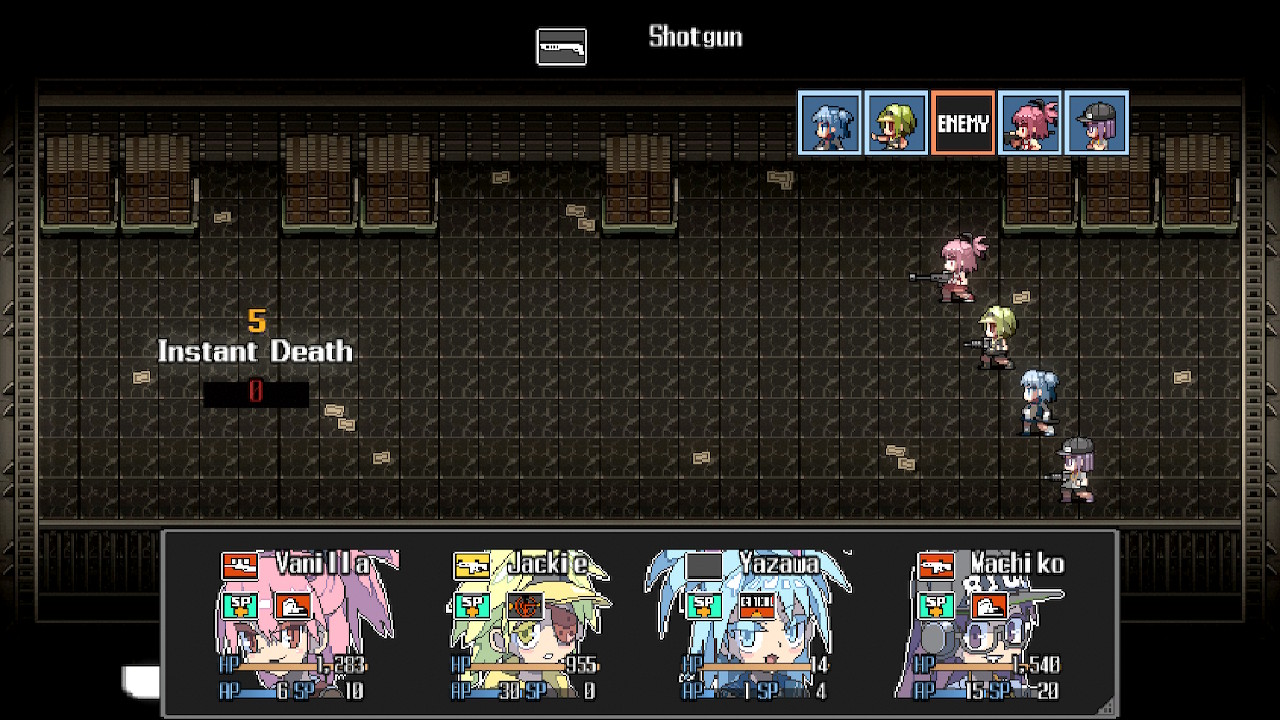
In fact, this was when I learned how to truly bend the game over my knee and give it a paddling it wouldn’t forget. That gun drops the character who uses it’s HP to 1% of normal, but she’s also wearing unique shoes that give her +60% base dodge rate, and her helmet gives her +30% more dodge rate while she is in Target Concentration, the status you have when you taunt an enemy. One of Jackie’s specials is Taunt. Her other is one that lets her counterattack anyone who misses her for massive damage. Add to this the fact that the “flame” status effect drops enemy accuracy, and you can have over a 100% evasion rate, and that I gained an SMG that has a very high rate of inflicting flame each attack and attacks 10 times. This end-game enemy has a knife attack that deals several thousand damage, for example:
(Attacks against multiple enemies like Suppressive Fire are unaffected by Target Concentration.)
Fighting fair is for chumps in this game. And chumps die first.
All Hail Your Lord and Savior, RNGesus!
So, combat is extremely simple. In most rounds, putting instant skills aside, your actual action for a round of combat is either going to be normal attack, your special (if you have SP for it), or reload. This extreme lack of flexibility and the absurd lethality of combat mean that your stats and random enemy move choice determine victory and your mid-battle decision making doesn’t matter much. (Even against that absurdly overpowered boss, he would sometimes just pick the evasion up move four times in a row, even though the evasion up status effect does not stack.)
So, somewhat like Fae Tactics, you have a game where facing a tough boss means having to rethink your character build to face the challenge at hand… except unlike Fae Tactics, where you could respec characters freely, Orangeblood has characters built entirely by their equipment choices.
That equipment is, once again, completely randomized in Diablo-style, and absurdly swingy in its power, with some “common” weapons being more powerful than “legendary” weapons.
The big problem, however, is that you hit these massive spikes in difficulty when you get to certain bosses, and there’s basically no way to deal with them outside of status effects that are only possible to reliably apply if you have a “unique”-rarity weapon that has a massive bonus to inflicting status effects (which also tend to cripple your other stats). You have basically no way of getting these weapons, other than running around like a headless chicken fighting everything until the game gives you one of the ultra-rare drops, and no amount of player skill matters.
Adding up all the things I said about equipment synergies meant that I basically only changed equipment about 3-4 times per character during the entire course of the game. Once I had a combo that worked, unless I had equipment whose base stats were twice what the equipment I had were, why would I break up my winning combo? (Once I have 100% evasion on my taunting character equipment, why ever use anything else?) The randomized equipment perks so rarely align properly that 99% of gear is just vendor trash, even if it’s “legendary” or “unique” rarity! (Amusingly, the game even features recycling machines as a way of emptying out your inventory. They pay out the same as vendors.) I was even using one piece of level 4 equipment from the very first few fights in the game all the way to the end of the game.
If you run into a brick wall like that boss that obliterated me time and time again, there’s basically nothing you can do but save, run out and try your luck with the loot boxes, and if you don’t see some combo of equipment that wins the game for you, you just have to savescum and try again.
Luck or savescumming until you get lucky is the only method to victory. In a game that I otherwise was enjoying, it really brings the game down to have something where your own actions are almost ancillary to whether you’ll succeed, and success is measured in having rolled up good drops.
Progression
The plot goes through a bizarrely rhythmic routine. First, you have a seeming distraction from your main mission where you get into a fight with one of the gangs that run a part of New Koza, and fight a boss to take over their territory in a manner not dissimilar to GTA. Then, you get in contact with the hacker who gives you the keycard to the next tier of the core structure that forms the main “dungeon” of the game. This “dungeon” section has by far the largest maps filled with the most enemies and the most loot. After getting to the end, of a tier, you fight a robot boss before getting extra chests that don’t take keys, get on an elevator to the next tier, and find that you need a new keycard from the hacker to continue, and she won’t give it to you until you do the next territory mission. Side quests also unlock at this point.
The main dungeon is notably where the main plot progresses and has the most combat and exploration and general “RPG gameplay stuff”, but it’s only filled with robot enemies that don’t talk to you. The territory mission and side quest stuff has all the dialogue and cool scenery and all the stuff that is actually good about the game. This sharp dichotomy is strange, but it really underlines how sometimes the “game part” of the game can be the least interesting part of a game.
Music
For a game revolving entirely around the aesthetics of 90’s hip-hop, you might expect a game with a real focus upon its music. Well, you’d expect wrong. You should expect that a super-indie developer like this would be capable of either developing interesting original graphics or composing original music, and this dev obviously put their eggs in the “graphics” basket. (Go play Touhou if you want a one-man band that produces great music with crap art.)
There are about a half dozen tracks in the entire game, and some of them are essentially background noise of people chattering in a marketplace with no tune. That last one gets old fast when you hear the same woman yelling every 30 seconds, and in dangerous zones, the music doesn’t stop between battles. Dangerous zones are silent until you get into a fight, and then it’s combat music until you leave just so there’s only one tune playing the whole time.
Still, I, personally, didn’t get tired enough of it to turn it off entirely, so it’s not all that bad by my own subjective standard, but that may be partly due to the shortness of the game, as well.
Graphics
So, here is a game where someone made a proper JRPG in RPGMaker, and did it with so many original assets that they wind up making it difficult to recognize it even is an RPGMaker game, outside of reusing some of the sound effects. I believe, but cannot confirm, that every single visual asset is original.
That said, this comes at a cost. This is obviously a game made with limited manpower and budget, so the developer chose quality over quantity when it came to art assets. Almost everything any character does is animated using detailed spritework, and the main characters have dozens of animations in particular (including different animations for each type of gun they can use), yet the game has about 20 types of enemies, tops. You wind up fighting the same enemies throughout nearly all of the game, just leveling up to keep up with the area’s level. This isn’t even a palette swap with some new moves, they are literally the same enemy, but with the numbers made bigger.
One more issue is that Japanese, thanks to kanji that represent whole words, tends to compress the same sentence into half the text length as English does. This causes some interface issues when some weapons with extreme numbers of special abilities spill out of their text box. Likewise, the text for the names of weapons will shrink horizontally to fit the name of a weapon, no matter how long it is, but the very blocky and pixelated nature of how the font is represented means this quickly becomes illegible.
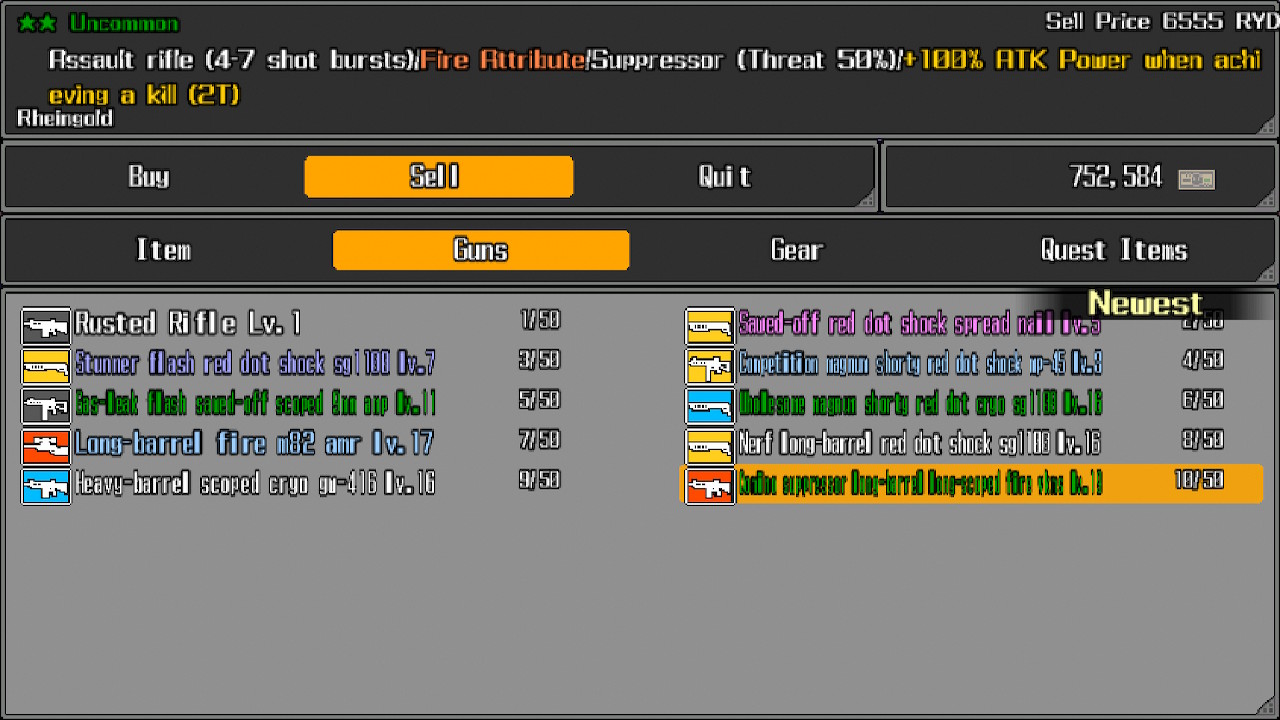
Another interesting, yet likely useless thing is that there are graphics options. This can apply or remove various filters that change how the game is presented in quite stark ways. “Flat” and “vibrant” make things the easiest to see, “cinematic” is a pretty way to view things that I used most of the game, and there are others like making the game “gray” or “old” that seem like a joke. There are other effects like tilt shift that make the screen darker and blurrier near the top and bottom of the screen. There are other filters that aren’t options that do things like represent day/night passage, so using a lot of effects can make it extremely difficult to see in some maps. Tilt shift in particular is one you should turn off to see enemies in the top or bottom third of the screen unless you want to navigate entirely by minimap.

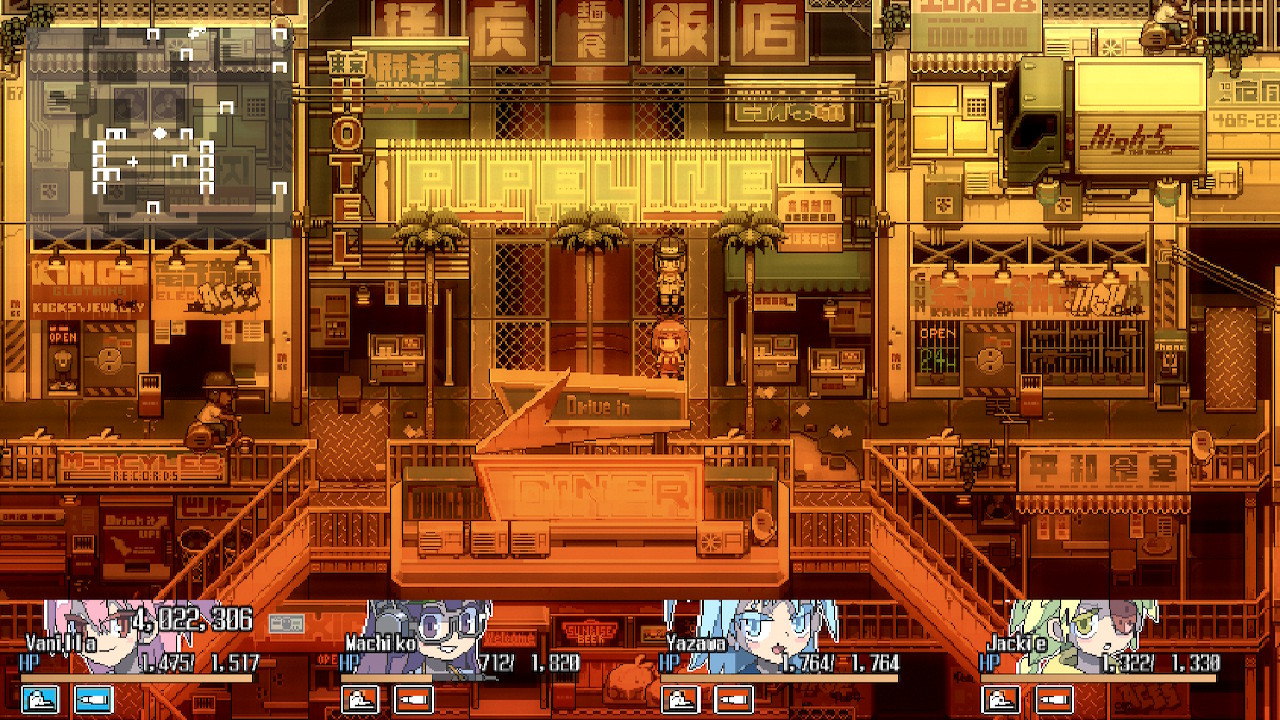
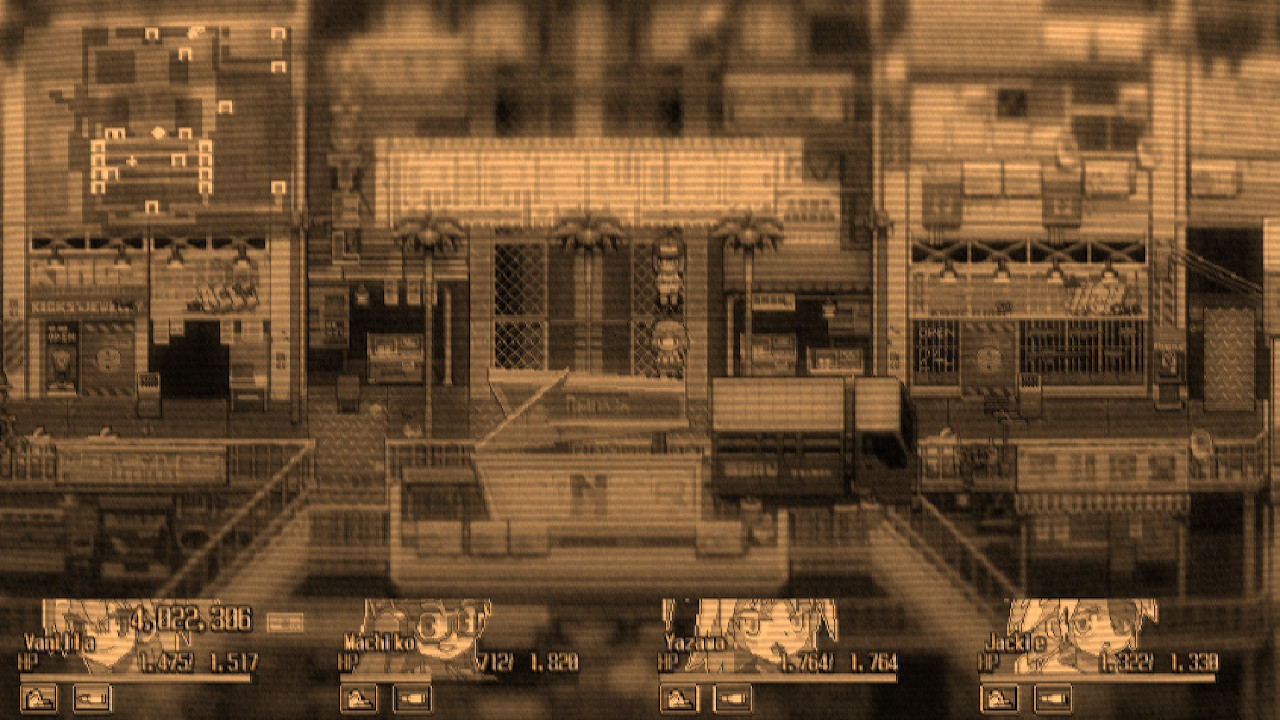
This Software Had to Close
Let’s not mince words. The port is bad.
I don’t know if it was a bad port job or if there’s something specific to RPGMaker and Switch hating one another, but the game is just SEVERELY unoptimized to the point that the game chugs. You can look at that trailer video up at the very top of this review, and see how fast animations like Yazawa’s “Schwing” attack are there, then compare them to the gameplay footage I got. The game plays at about 1/4th the speed it should. (I don’t have the game on Steam, but I compared it to PC Let’s Plays, as well. They’re definitely playing a much faster game than I am.) At times, the game lags two or three seconds just trying to move up or down in the menu.
At one point, after having cleared the first tier, I went back to the main map, sold off my junk, then was heading back to a good position to save (so that if I reload, I was near where I would start the next important bit)… and it crashed. Due to the way that you can only save on the “main map” (the top of the oil rig) or a bed in a residence you’ve claimed ownership over, you can go as much as an hour between places to save if you’re running back and forth trying to grind weapons and gear. It is, needless to say, painful to lose an hour’s worth of progress, and even worse if you picked up good gear while doing it. While I fortunately only had a major loss of progress once due to crashing, I took to closing out the game and restarting after every save, because it seems like there’s some kind of memory leak or something that causes the game to lag more and more as you leave it open. (When I first start up the game, it notably has a framerate twice as good as when I have loaded a couple more screens and start doing things.) I recommend going through a dungeon normally until you hit an area that seems like it will have a boss, then running back out, saving, restarting the game, then beelining to the boss without getting into fights just to be safe. Even so, I had some times where I had a crash just after I’d restarted, and was just going through my inventory to switch equipment around. (Good thing I’d adopted a habit of saving before and after switching equipment…) All told, I had four crashes.
Here’s a transition to a minor cutscene that takes 11 seconds after loading up a fresh save to demonstrate:
What really makes this a problem is that the game runs at the speed of its framerate. By this I mean that when you’re getting 15 FPS, everything in the game takes twice as long to happen as at 30 FPS. When the game really starts chugging, it starts making every round of combat take a minute, and transitions between the battle screen and the movement screen take four seconds, dragging the game out needlessly. (I could probably have halved the playtime if the game just ran faster.)
RPGMaker games can run on a potato. There’s no good excuse for room transitions to take four seconds, or a sub-10 FPS.
Verdict
Orangeblood is a short game for a JRPG. I completed in in about seven and a half hours of playtime recorded on my save, but I probably have another hour or two that was lost to crashes or restarting trying to get lucky and dodge a brutal boss combo. If you get lucky and don’t get stalled at certain bosses, you can probably speedrun it at four hours or so. That said, the game doesn’t feature enough depth to really keep you playing longer, so keeping things from overstaying their welcome is for the best. You’re playing this for the dialogue, the aesthetic, and the irreverence, and those have a real shelf life. I enjoyed playing Orangeblood, but pushed forward to finish it mostly just because I smelled the finish was close enough to drive me on.
Get it on Steam/PC. I’d give this game a “Save” if it weren’t for the technical issues. There isn’t a reason to put up with crashes and lag when there’s a better-running version out there. It’s hard to recommend at full price for a game that can be over in about 8 hours, not counting bonus dungeons, but if you can get it below $10, then by all means, enjoy it.

